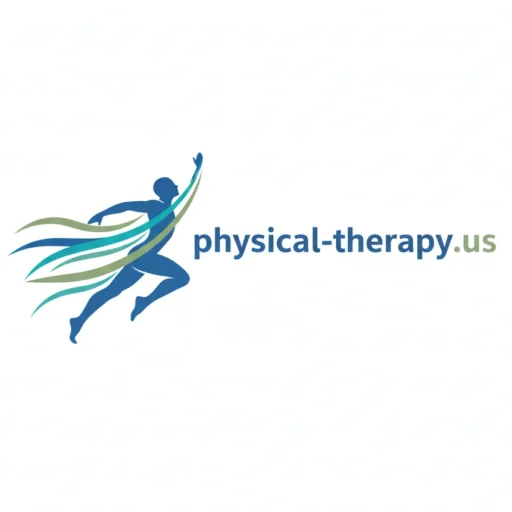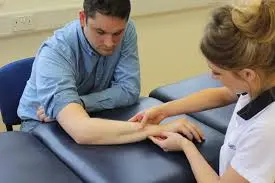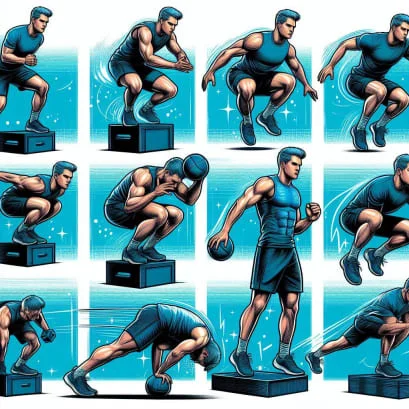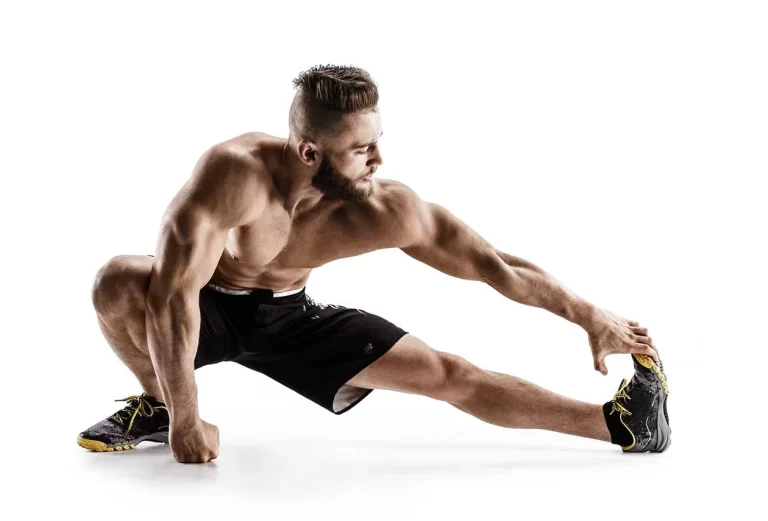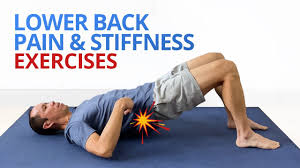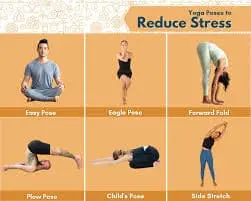13 Best Exercises For Colle’s Fracture
Introduction:
A Colles fracture occurs when one of the forearm’s bones, the distal radius, breaks. Falling on an outstretched hand is frequently how this happens. Your wrist is typically immobilized in a plaster cast after a Colles fracture to promote recovery. When the cast is removed, your hand and wrist could feel uncomfortable and inflexible.
The goal of Exercises for Colle’s Fracture after the fracture is healed is to increase arm and wrist strength and range of motion. You will receive workouts from your physical therapist to restore your usual range of motion. An essential component of your Colles fracture rehabilitation is the at-home workout regimen. Your physical therapy treatments may benefit from the exercises you do at home.
Causes:
Fall on a Hand Outstretched
- This is the most common reason for a Colles’ fracture.
- If someone prevents a fall with their hand, their wrist bears the entire weight of their body.
- The wrist breaks if it is stretched (bent backward) because the stress reaches the distal radius.
- A Colles’ fracture is characterized by the distal fragment being forced backward (dorsally) by the impact.
High-Energy Trauma in Children and Teens
- Despite being more prevalent in the elderly, Colles’ fractures can affect younger people for the following reasons:
- Accidents involving cars or motorcycles
- Sports injuries (like those from skating or snowboarding)
- Drops from a height
Osteoporosis, or Bone Weakness
- A significant risk factor, particularly for postmenopausal women and older persons.
- Even mild trauma, such as falling from a standing height, can result in fractures in osteoporotic bones.
- The radius fractures more easily under pressure because the bones are thinner.
Repetitive stress injuries or occupational injuries
- Jobs that require a lot of wrist extension or pressure can cause repetitive stress on the wrist, which can weaken the area or increase the risk of stress fractures.
- Rather than a traditional Colles’ fracture, this is more likely to result in wrist strain or additional fractures (such as scaphoid).
Poor Vision or Balance
- Raises the risk of falls.
- Prevalent in the elderly and those suffering from neurological or vision disorders.
Signs and symptoms:
Painful or Restricted Movement
- Extremely limited range of motion, particularly in wrist flexion and extension
- Pronation or supination of the forearms.
- Trying to move the fingers or wrist frequently hurts.
One of the “dinner fork” abnormalities.
- The hand and wrist seem to be bent backward and upward, like the shape of an upside-down fork.
- Caused by the radius’s distal fracture fragment angulation and dorsal displacement.
The pain
- Acute, severe pain in the forearm and wrist region, particularly with the distal radius.
- Gets worse with pressure or movement.
- To avoid movement, patients frequently support the injured arm.
Incapacity or Weakness to Hold
Patients frequently have trouble holding objects or making a fist.
- Pain is the cause of weakness.
- Loss of wrist mechanical leverage
- Potential involvement of nerves
Inflammation and bruising
- Bleeding and soft tissue damage cause the wrist and forearm to expand rapidly.
- Ecchymosis, or bruises, can develop soon after the injury and occasionally spread to the hand or forearm.
Feeling Sensitive to Touch
- The impacted region is extremely sensitive.
- When the distal radius is palpated, serious pain is felt.
Benefits of exercise:
Following a Healing of Colles’ fracture, exercise is essential. A focused exercise program helps in regaining the wrist, hand, and forearm’s strength, mobility, and function after the bone has accurately healed and has been approved by a physician or physiotherapist.
Reduce Stiffness and Pain
- Moving slowly helps to make the area and ease any remaining tightness or soreness. By carefully loading the healing tissues, hypersensitivity is decreased and user comfort is increased.
Minimize Swelling and Enhance Blood Flow
- Remaining edema is decreased, and healing is helped by movement, which promotes blood flow and lymphatic drainage.
- This is particularly beneficial in the wrist and fingers, where edema can affect function.
Improve Hand and Grip Capabilities
The thumb, finger flexors/extensors, and intrinsic hand muscles can be worked using the following exercises:
- Restore your mobility.
- Increase your coordination.
- Make writing, buttoning garments, and lifting objects possible.
Encourage the Remodeling and Healing of Bones
- Strengthening and controlled weight-bearing are encouraged.
- Strong bone recovery is guaranteed.
Gain Strength in Weak Muscles
- During immobilization, the wrist, hand, and forearm muscles frequently atrophy.
- Exercises for strengthening: Restore function and grip power
- Avoid getting hurt again.
- Improve self-reliance in day-to-day activities.
It is important to think about certain safety precautions before starting an exercise program:
Before starting any exercise program, it is crucial to enhance the benefits and take into account a few safety precautions. Ask your physician or physical therapist what exercises are best for your specific issue.
It’s key to listen to your body’s requirements and refrain from pushing yourself when it’s painful. A common side effect of exercise is pain, but severe or persistent pain may be a sign of overwork. Work your way up from low-impact exercises to ones that cause greater pain if you can.
Maintaining good posture and form can help avoid repetitive injuries. Consult your doctor for advice on how to start exercising properly. Warm up your muscles and joints before starting an exercise to get them ready.
Exercises For Colle’s Fracture:
Wrist curl
- Initially, sit down in a chair.
- You should put a resistance band that may be adjusted around your right palm.
- Place the heel of your right foot on the opposite band end.
- With your palm facing up, press your right elbow against your right thigh.
- Raise your fist to your body’s center.
- Hold this position for a few seconds.
- Then return to your neutral position.
- Then relax.
- Repeat these exercises 5 to 10 times.
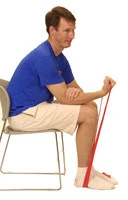
Wrist circle
- Start by finding a comfortable spot on the floor to sit or stand.
- Put your hands shoulder-high and tighten them into fists.
- Rotate your wrists to the left, flexing them up, while maintaining the same elbow posture.
- Afterward, flexing them down to the right.
- Then return to your neutral position.
- Then relax.
- Repeat these exercises 5 to 10 times.
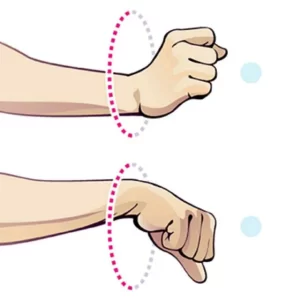
Thumb flexion
- Start by taking a comfortable seat.
- Start by holding out your left hand in a straight grasp with all of your fingers.
- Stretch your thumb out to the base of your little finger.
- You should not be concerned if you cannot reach your little finger.
- Put simply, extend your thumb as far as it will go.
- Hold this position for a few seconds.
- Then return to your neutral position.
- Then relax.
- Repeat these exercises 5 to 10 times.
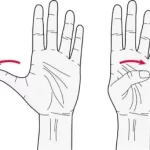
Wrist flexion and extension
- Place your forearm comfortably on the table and place your hand over the edge.
- The hand is then pointed downward towards the floor after the wrist has been bent.
- Hold this position for a few seconds.
- After that, raise it until it points upward.
- Hold this position for a few seconds.
- Then return to your neutral position.
- Then relax.
- Repeat these exercises 5 to 10 times.
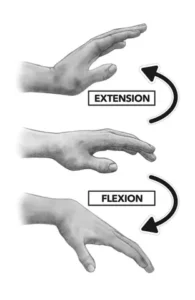
Wrist Side-to-Side (Radial and Ulnar Deviation)
- Start with the seating position at the table.
- Keep your wrists and fingers straight.
- Maintain your forearm position.
- Start by moving your hand to your little finger.
- Hold this position for a few seconds.
- Then proceed once more towards your thumb.
- Hold this position for a few seconds.
- Then return to your neutral position.
- Then relax.
- Repeat these exercises 5 to 10 times.
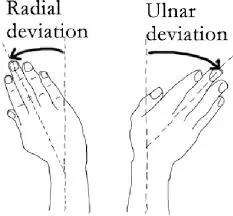
Prayer position
- Begin by standing on the ground.
- Position your hands in front of your body to form the praying position.
- You’ll be elbows out to the sides.
- To make your chest appear larger, slowly move your shoulders back.
- Try to keep your fists together tightly.
- Hold this position for a few seconds.
- Then return to your neutral position.
- Then relax.
- Repeat these exercises 5 to 10 times.
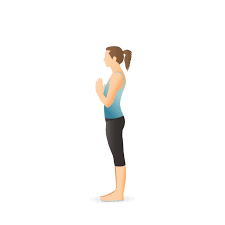
Elbow bend
- Let’s begin by standing on the floor.
- Your hand should touch your shoulder as you progressively bend your arm upward.
- Hold this position for a few seconds.
- Next, drop your arm.
- Then return to your neutral position.
- Then relax.
- Repeat these exercises 5 to 10 times.
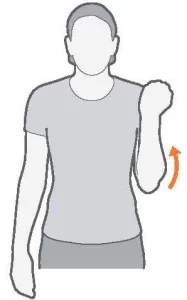
Finger Spreading Exercise
- Take a seat comfortably to begin.
- Straighten your fingers.
- Make sure your thumb is facing your palm.
- Hold this position for a few seconds.
- Then return to your neutral position.
- Then relax.
- Repeat with the remaining left-hand fingers one at a time.
- Repeat these exercises 5 to 10 times.
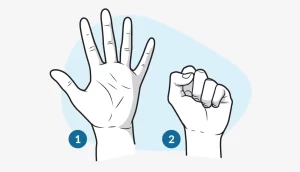
Hand clench
- Beginning by standing on the ground.
- Next, make a straight finger extension.
- Gently clench the hand into a fist.
- Your thumb is wrapped around your fingers.
- Hold this position for a few seconds.
- Then return to your neutral position.
- Then relax.
- Repeat these exercises 5 to 10 times.
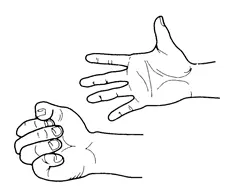
Ball squeeze
- Get started by standing on the floor.
- Then pick up a tennis ball.
- Next, squeeze the ball between your fingers.
- Hold this position for a few seconds.
- Then return to your neutral position.
- Then relax.
- Repeat these exercises 5 to 10 times.
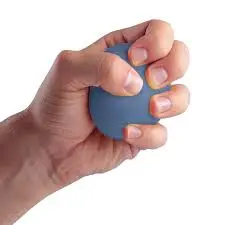
Wrist turn
- Get started by standing on the floor.
- After that, extend your hand and bend your elbow straight.
- Palm facing up, with minimal or no weight on it.
- Rotate your wrist slowly while keeping your palm down.
- Hold this position for a few seconds.
- Then return to your neutral position.
- Then relax.
- Repeat these exercises 5 to 10 times.
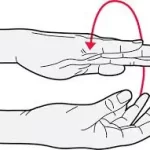
Finger and Thumb touch exercise
- Choose a comfortable sitting position to begin.
- Keep your wrist straight.
- Using your thumb, gently trace an “O” with each of your four fingertips, one at a time.
- Then return to your neutral position.
- Then relax.
- Repeat these exercises 5 to 10 times.
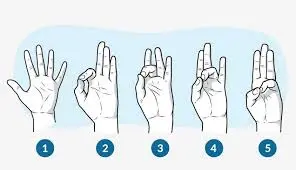
Tendon Gliding Exercises
- Begin by standing on the floor.
- Make sure all of your fingers are entirely straight while holding your hand in front of you, and your wrist joint is straight.
- Put your fingertips in the “hook” position, bending them until your knuckles point upward.
- Using your thumb, clench your fist over your fingers.
- Keeping your fingers straight and bending at the bottom knuckle, create a “tabletop” with your fingers.
- Bend your fingers at the middle joint and touch your palm with your fingers.
- Then return to your neutral position.
- Then relax.
- Repeat these exercises 5 to 10 times.
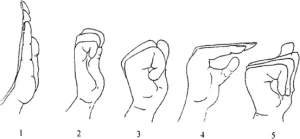
What security measures should be taken when exercising?
Following certain safety precautions when performing exercises is essential when recovering from a Colles’ fracture to promote proper healing, prevent complications, and maximize functional rehabilitation.
Following immobilization and injury, the wrist and associated structures are particularly vulnerable, making these protective measures essential.
Get warmed up before working out.
- Make use of a heating pad or a warm water bath.
- Gets muscles and tendons ready for action.
Keep Your Techniques Good
- Exercise should always be done carefully and slowly.
- Don’t move quickly, forcefully, or jerkily, especially when: Flexing or extending your wrists.
Employ Proper Resistance: Begin with little to no opposition.
- Increase gradually only with supervision.
- In early rehabilitation, refrain from using large weights or tightly holding things.
Make a Gradual Advancement
- Start with range-of-motion (ROM) exercises before progressing to weight-bearing and strengthening exercises.
- Don’t move quickly, forcefully, or jerkily, especially when: Flexing or extending your wrists.
Keep an eye out for fatigue and swelling.
After working out, look for:
- Swelling: A rise in redness
- Unusual warmth
Ice the affected region and let your therapist know if any of these happen.
Keep an Eye Out for Complication Signs
- Inform your physician or therapist if you come across: Enhanced pain or edema.
- Tingling or numbness (possible compression of the median nerve) Loss of mobility
- Not getting better at grip weakness.
Engage Every Affected Area
Don’t ignore joints that are related:
- Elbow and shoulder
- Thumb and fingers
When did you quit working out?
Following a Colles’ fracture, rehabilitation activities are essential for recovering full function, but they must be performed correctly and securely.
There are certain obvious situations in which you should temporarily stop exercising or alter your regimen.
Sharp or excruciating pain during or after physical activity
- It’s common to experience little pain, particularly during early movement.
- On the other hand, intense, sharp, or increasing pain is a warning sign.
- Overuse or poor technique may be the cause of pain that persists into the following day.
Burning, tingling, or numb feelings
- May indicate compression of the median nerve, particularly if the wrist is still swollen.
- Stop performing wrist pressure or resistance workouts.
- If symptoms don’t go away, have a medical or neurological evaluation.
Extreme Weakness or Fatigue
- Your wrist, shoulder, elbow, and upper back can all become fatigued from overtraining during rehabilitation, particularly if they haven’t been used.
- Fatigue raises the possibility of injury and poor form.
Inflammation or Swelling Following Exercise
Although some edema is to be expected;
- Swelling that is new or worse.
- Warmth, tightness, or redness
- These could be signs of joint or tendon inflammation or overuse.
Which exercises should you avoid if you have a Colle’s fracture?
The following exercises and activities should be avoided until a physician or physical therapist gives the all-clear:
Weigh-bearing Activities for the Wrist.
- Push-ups
- Planks
Resistance training or heavy lifting
- Don’t lift large weights, especially while performing overhead lifts, bench presses, or wrist curls.
- In the early stages of rehabilitation, stay away from utilizing resistance bands that overstress the wrist.
Bending the Wrist Deeply or Forcefully
- Forceful flexion or extension of the wrists (such as pressing hands against a surface to stretch)
- Pose types in yoga include upward-facing dog, downward dog, and cobra.
- These may put stress on the soft tissues and healing joints before strength and mobility are recovered.
Forceful or Startling Motions
- Using your arms to cushion impact while sprinting or jumping
- Sports like martial arts, basketball, and tennis
- The risk of falling or having a sudden impact on the healing bone is increased by these activities.
Summary:
Your hand and arm may become significantly less functional as a result of a painful Colles fracture. You can restore your arm and hand’s natural, functional use by learning the proper exercises.
Increasing the range of motion in your wrist, strengthening your grip, and strengthening your fingers and wrist are some examples of this. Consult with your doctor before beginning these workouts on your own. They can guarantee that they won’t hurt you further and that you’re protected.
After a Colles’ fracture, a systematic fitness program is essential to a successful recovery. The majority of people regain normal wrist function with time, effort, and medical professionals. Every healing path is different, so pay attention to your body and make adjustments as necessary.
FAQ:
When a Colles fracture occurs, which nerve is injured?
Most often, the median nerve is in danger of injury in Colles’ fractures. The fracture may compress or stretch the nerve, resulting in edema and deformity. Although they are less common, other nerves, such as the ulnar nerve, may also be impacted.
What is your sleep pattern while you have a Colle’s fracture?
The most comfortable position for someone with a broken arm or wrist is frequently supported up on pillows. This keeps the damaged part elevated while allowing gravity to relieve some of the tension.
How soon after a Colles’ fracture can I begin exercising?
During the immobilization period, you can start with mild workouts for your fingers and shoulders. As directed by your physician, wrist and forearm workouts usually start 6–8 weeks after the accident, or after the cast or splint is taken off.
Is experiencing pain while exercising normal?
It’s common to feel a little tight or uncomfortable, especially at first. On the other hand, severe or growing pain is a warning sign. Talk to your doctor and discontinue the workout if the pain persists.
How frequently ought I to perform the exercises?
Depending on your comfort level and recuperation stage, you can perform most exercises two to three times a day. Three to four times a week is a good starting point for strengthening workouts.
Can someone who has had a Colles fracture lift weights?
Yes, but only once your doctor certifies that the bone has sufficiently healed, which usually happens 8 to 12 weeks after the incident. With the guidance of a physical therapist, begin with very modest weights (1–2 lbs) and raise them gradually.
After working out, what should I do if my wrist feels stiff?
After applying ice to the wrist, let it rest for ten to fifteen minutes. At first, little swelling is normal, but if it gets worse or doesn’t go away, get help from a physician.
Should I refrain from any activity while I’m recovering?
Indeed. Refrain from: Heavy lifting, pulling, and pushing movement.s Sports or activities with a high impact until your doctor or therapist has cleared your wrist and it has completely recovered.
What happens if, after a few weeks of exercise, I don’t see any improvement?
See your physical therapist or orthopedic expert if, after two to three weeks of consistent exercise, your range of motion, strength, or pain isn’t getting better. You could require a more customized treatment program.
Why does the term “dinner fork deformity” refer to Colle’s fracture?
When viewed from the side, tines down, the wrist’s lateral shape resembles that of a fork; therefore, the meaning of the condition.
Which splint is best for a Colles fracture?
Colles fractures can be supported radially and ulnarly using the aluminium Colles Splint. uses ulnar deviation to stabilise the wrist, reducing flexion and pronation. A powder-coated metal splint is clear, flexible, and has a nice foam interior.
References:
- Exercise regimen for physical treatment following a college fracture – 2025 – Pt
- The adult Physiotherapy Division, Johnson, Norris, Post-Colles Fracture a type of 2010
- Types of Colles Fractures, Symptoms, and Physiotherapy Treatment
- Northern Devon Healthcare NHS Trust: Colles fracture
- How an administrator handles a colles fracture in 2024
- Following Colles’ fracture, physical rehabilitation – Blog | Axis Orthopaedic Hospital – 2018 – Axis_blog
- Advice for Colles Fracture after Plaster Removal (2006)
- Exercise regimen for physical treatment following a college fracture
- Exercises for Phase 2 of the Distal Radius Wrist Fracture Surgery Home Program by Gesensway
- Image 4, Five Ways to Make Your Hands More Mobile – 2020 Kaden, Frank E., D.C. Chiropractic, Inc.
